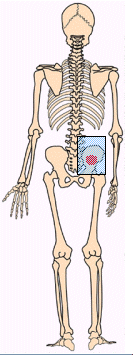The
palliation of symptomatic osseous metastases: final results of the Study by the Radiation
Therapy Oncology Group.
Tong. Cancer 1982 Sep 1;50(5):893-899
Ninety percent of patients experienced some relief of
pain and 54% achieved eventual complete pain relief. The low-dose,
short-course schedules were as effective as the high-dose protracted programs.
Reanalysis of the RTOG study
of the palliation of symptomatic osseous metastasis.
Blitzer. Cancer 1985 Apr 1;55(7):1468-1472
The RTOG multicenter clinical trial studied pain relief in 759 patients randomly assigned
to a variety of dose-fractionation schedules: 270 cGy X 15 fractions, 300 X 10, 300 X
5,400 X 5, and 500 X 5. The results differed from a previous report in that
number of fractions was statistically significantly related to complete combined relief
(that is, absence of pain and cessation of the use of narcotics). The conclusion is that protracted dose-fractionation schedules are more
effective than short course schedules.
Single-dose half-body irradiation for palliation of
multiple bone metastases from solid tumors. Final Radiation Therapy Oncology Group report.
Salazar. Cancer 1986 Jul 1;58(1):29-36
This is the final analysis of Protocol #78-10 which explored increasing single-doses of
half-body irradiation (HBI) in patients with multiple (symptomatic) osseous metastases.
When given as palliation, HBI was found to relieve pain
in 73% of the patients. In 20% of the patients the pain relief was
complete; over two thirds of all patients achieved better than 50% pain relief. The HBI
pain relief was dramatic with nearly 50% of all responding patients doing so within 48
hours and 80% within one week from HBI treatment. Furthermore, the pain relief was
long-lasting and continued without need of retreatment for at least 50% of the remaining
patient's life. The most effective and safest of the HBI doses tested were 600 rad
for the upper HBI and 800 rad for the lower or mid-HBI. There were excellent
responses found in practically all tumors treated, but especially breast and prostate
among which over 80% of all patients experienced pain relief, 30% in a complete fashion.
Single-dose HBI emerges as one of the safest, fastest, and more effective palliative tools
for intractable cancer pain in modern radiation oncology.
Fractionated half-body irradiation for pain
palliation in widely metastatic cancers: comparison with single dose.
Salazar. Int J Radiat Oncol Biol Phys 1996 Aug 1;36(1):49-60
The HBI techniques used on consecutive patients were: single dose (SD) in 54% with
escalating doses of 4-10 Gy; split-course (SC) in 12% with two 4 Gy single doses separated
by 2 weeks; and daily fractionated (DF) in 34% with five fractions
of 3 Gy each. There were 68 of 75 HBI (91%) given for pain control purposes.
RESULTS: The percent total (complete) pain relief
was SD-73(32), SC-50(13), and DF-96(49). Time to maximum and
(complete) relief was: SD 5 days each and DF HBI 7(11) days. Pain-free survival (PFS) was
short but so was overall survival (OS). PFS was SD-5, SC-4.5, and DF-19 weeks. The percent
of the remaining patient's life spent pain free without retreatment (NPR) was SD-38,
SC-34, and DF-68. Differences in pain relief, PFS, OS, and NPR were significant and
carried over primary tumor types; prostate, breast, and surprisingly GI were very
responsive (90, 84, and 83%, respectively). Despite lack of premedication in DF-HBI,
toxic reactions were identical to SD-HBI with premedication. Fractionating HBI eliminates
need for the premedication and close patient monitoring required for SD-HBI. It also
allows for an increase in total dose which can produce better responses in pain relief,
duration of relief, PFS, OS, and quality of life.
Strontium-89--precursor targeted therapy for pain
relief of blastic metastatic disease.
Robinson RG Cancer 1993 Dec 1;72(11 Suppl):3433-3435
Strontium-89 is a radioactive calcium analog that provides an energetic beta particle for
radiation therapy of osteoblastic disease. Strontium-89 is used as palliative therapy with
the primary goal being pain relief. More than 500 patients with painful blastic metastatic
disease were treated at University of Kansas Medical Center Improvement
(decrease in pain, increase in physical activity level) was noted in 80% of patients with
prostate carcinoma and 81% of patients with metastatic breast cancer to bone.
Marrow toxicity levels were acceptable. The therapy can be repeated at 3-month intervals.
Strontium-89 is a safe and effective systemic therapy for painful blastic metastatic
disease. There is no longer any reason why the vast majority of persons with painful
blastic metastatic disease should continue to hurt. |
